How to Fix Lifting and Peeling Vinyl Wrap on Car Doors
To fix vinyl wrap doors lifting and peeling on your car, first assess the extent of the damage. Clean the area thoroughly to guarantee adhesion. Use a heat gun or hairdryer to soften the Vinyl, then carefully press it back into place, smoothing out any air bubbles with a squeegee. For more significant peeling, trim away the damaged Vinyl and replace it with a matching piece. Regular maintenance, like gentle cleaning and using a UV-resistant clear coat, can prevent future issues. Exploring additional techniques can further enhance your how-to-fix vinyl wrap doors, lifting the car’s durability and appearance.
How to Fix Peeled Vinyl Doors on Your Car
Repairing peeled Vinyl on car doors requires a systematic approach to guarantee durability and aesthetics. If you’re exploring broader styling or branding options beyond just repair, this complete guide to vehicle liveries offers valuable insights into full-body wraps and custom designs for cars.
This process includes a step-by-step repair methodology, specific tools for effective application, and best practices to achieve a long-lasting finish.
Understanding these elements is essential for restoring the appearance and protection of your vehicle’s doors.
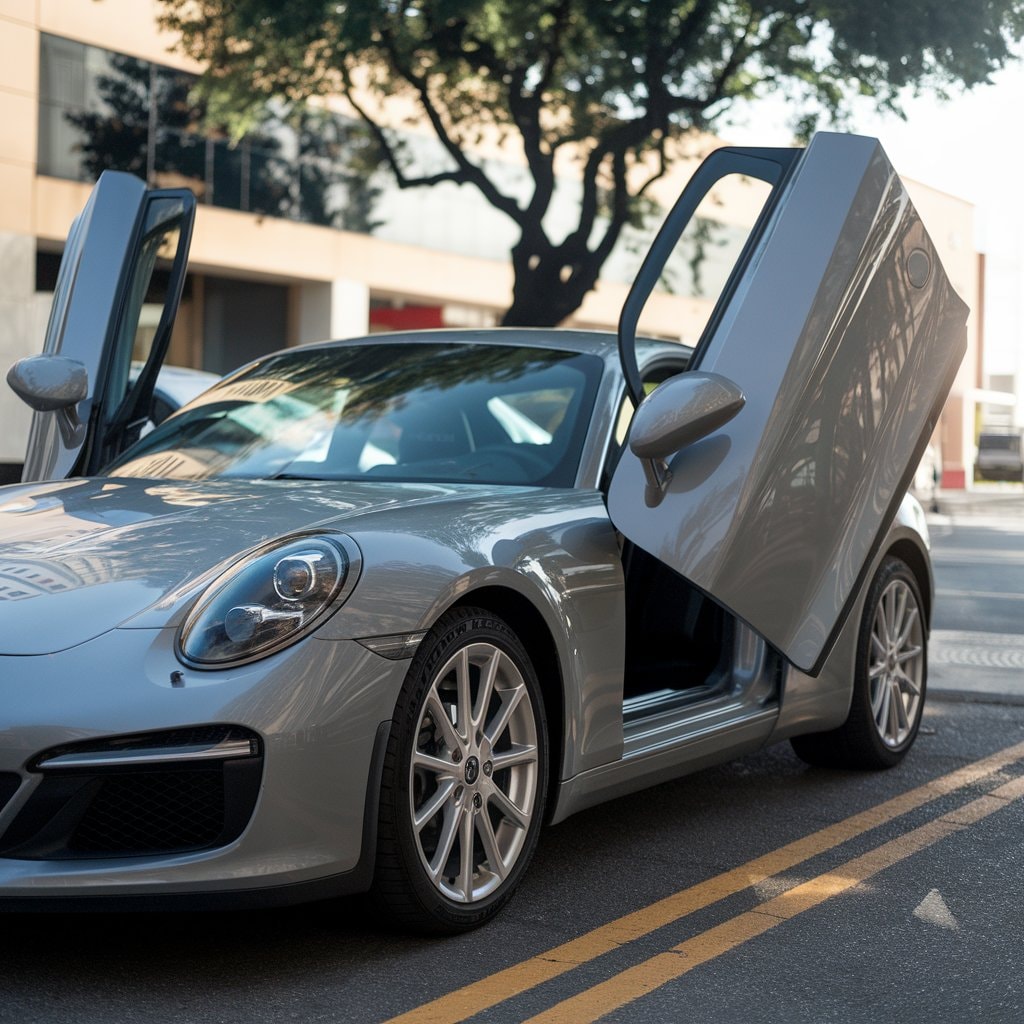
Step-by-Step Door Vinyl Repair Process for Cars
A successful vinyl wrap door repair process can reinstate the visual charm and practicality of your vehicle’s doors with relative ease.
Begin by evaluating the extent of the peeling vinyl. If the damage is minor scratches or small areas of peeling, you can often repair the Vinyl by re-adhering the edges. Thoroughly clean the affected area to eliminate dirt and debris, ensuring ideal adhesion.
If there is any leftover adhesive from previous repairs or areas where the Vinyl has lifted, use an adhesive remover to clean the surface thoroughly. This ensures the new Vinyl will adhere properly.
Next, apply heat using a heat gun or hairdryer to soften the Vinyl. This will make it more pliable and easier to manipulate. Gently press the lifted section back into place, Making sure no air bubbles are trapped beneath.
For significant peeling, consider cutting away the damaged section of door vinyl and replacing it with a matching piece. After repositioning or replacing the peeling edges of the door handles the Vinyl, apply heat again to activate the adhesive.
Use a squeegee to smooth out the surface, removing any remaining air bubbles and ensuring a snug fit. Finally, allow the Vinyl to cool and set for at least 24 hours before exposing it to harsh conditions.
Following this step-by-step process will enhance the longevity of your vinyl wrap and keep your doors looking pristine.
Tools Required for Vinyl Wrap Repair on Car Doors
Essential tools for vinyl wrap repair on car doors guarantee a smooth and effective restoration process. Having the right equipment at hand can greatly enhance the quality of the repair, making sure that the Vinyl adheres properly and minimizes the chances of future peeling.
| Tool | Purpose |
|---|---|
| Heat Gun | Softens vinyl for better adhesion |
| Squeegee | Smoothens out air bubbles and wrinkles |
| Utility Knife | Cuts vinyl to size for precise fitting |
| Cleaning Solution | Prepares the surface by removing contaminants |
| Measuring Tape | Confirms accurate measurements of the doors |
These tools are essential for addressing peeling and making sure of a seamless finish. The heat gun is particularly important for activating the adhesive, while the squeegee helps eliminate any trapped air that can lead to further peeling. A utility knife allows for clean cuts, making sure that the Vinyl fits snugly around the edges of the front door handles and doors. Cleaning the surface is vital to guarantee that the Vinyl adheres properly, and using a measuring tape confirms that the Vinyl is correctly sized. With these tools, vinyl wrap repair can be performed efficiently and effectively.
Tips for a Long-Lasting Vinyl Wrap Fix on Your Car
To achieve a long-lasting fix for a peeled vinyl wrap on your car doors, it’s crucial to follow specific techniques that enhance adhesion and durability.
Start by thoroughly cleaning the surface of the vinyl wrap doors with isopropyl alcohol to remove any dirt, grease, or residues. This guarantees peak adherence when you reapply the material.
Next, use a heat gun to warm the Vinyl around the peeling area gently.
This will soften the Vinyl, making it more flexible and easier to manipulate.
Carefully lift the peeling section and apply a high-quality adhesive specifically designed for vinyl wrapping. Once the adhesive is applied, press the Vinyl back into place, smoothing out any air bubbles with a squeegee.
For added protection, consider applying a UV-resistant clear coat over the repaired area to shield against sun damage. Routine upkeep, including cleaning and steering clear of harsh chemicals, will also prolong the life of your vinyl wrap.
In cases where vinyl wrapping is needed to repair vinyl cabinets, the same techniques apply.
Why Does Vinyl Wrap Peel on Your Car?
Vinyl wrap can peel from car doors due to several factors, including improper installation, exposure to harsh environmental conditions, and the quality and age of the materials used.
Common causes, such as UV exposure and moisture, can weaken the adhesive, leading to premature deterioration. These problems, much like issues indicated by car dashboard warning lights, signal that your vehicle may require timely maintenance to prevent further complications.
Understanding these contributing factors is essential for maintaining the integrity of vinyl wraps on vehicles.
Common Causes of Vinyl Wrap Peeling from Car Doors
Peeling of vinyl wrap on car doors can occur due to several factors that compromise the integrity of the material. Understanding these causes is crucial to prevent issues before they escalate.
Here are some common reasons why Vinyl starts to peel:
| Pros | Cons | Considerations |
|---|---|---|
| Enhanced Aesthetic | Risk of Peeling | Quality of Paint Matters |
| Customization Options | Potential Damage to Vinyl | Proper Application Required |
| Increased Durability | Difficult to Remove | Compatibility with Vinyl |
| Cost-Effective Alternative | May Void Warranty | Test Small Area First |
These problems are often overlooked, and the reality is that they aren’t always immediately evident. While vinyl wraps may provide good short-term value, addressing the underlying issues is vital to prevent further complications. If you’re experiencing peeling vinyl-wrapped surfaces, it’s important to act swiftly. Get in touch with us today for professional advice and solutions customized for your vehicle.
Environmental Factors Affecting Vinyl Wrap Durability on Cars
Frequently, environmental factors play a significant role in the durability of vinyl wraps on cars. Exposure to extreme heat and weather conditions—such as prolonged sunlight, humidity, and temperature fluctuations—can lead to the deterioration of the adhesive properties and overall integrity of the Vinyl.
UV radiation is particularly damaging, causing the wrap to fade and become brittle over time, which may result in peeling.
Additionally, locations where road salt and pollutants are prevalent can accelerate the degradation process. These substances can break down the vinyl wrap adhesive, leading to lifting and peeling, similar to issues seen with peeling vinyl cabinets in damp environments.
Moreover, while many vinyl wraps are marketed as environmentally friendly, their long-term resilience can be compromised by environmental factors. Just as vinyl wrap car doors in humid conditions may experience issues, car wraps are not immune to the same vulnerabilities.
Proper maintenance and protective measures, such as regular washing and applying sealants, can mitigate these environmental impacts.
Ultimately, understanding how these factors influence vinyl-wrapped doors will help car owners maintain the aesthetic and functional quality of their vehicles for longer.
Quality and Age of Vinyl Wrap: Why Your Car Doors Are Peeling
Durability is a critical factor influencing the longevity of vinyl wraps, particularly as they age. The quality and age of the vinyl wrap play crucial roles in the performance and appearance of your car’s vinyl doors. High-quality vinyl wraps are designed to withstand environmental stressors, while lower-quality options may succumb to wear and peeling more quickly.
As vinyl wraps age, they become increasingly vulnerable to damage from UV exposure, moisture, and temperature fluctuations. This degradation can lead to vinyl-wrapped car doors peeling or peeling vinyl wrap car doors, which often mirrors the issues faced by vinyl doors on vehicles.
In addition, improper installation can exacerbate the deterioration of the wrap, leading to premature failure. For instance, if the Vinyl is not applied with sufficient heat or pressure, it may lift at the edges, creating a pathway for moisture to infiltrate underneath.
Ultimately, understanding the interplay between the quality and age of vinyl wrap is essential for maintaining the integrity of your vinyl car cabinets and ensuring that your car’s vinyl doors remain in ideal condition.
Regular maintenance and high-quality materials can greatly extend the life of the wrap.
Can You Paint Over Vinyl Wrap on a Car?
Painting over vinyl wrap on a car can provide a new aesthetic but comes with both advantages and disadvantages.
Proper preparation of the vinyl surface is essential to guarantee the adhesion and longevity of the paint.
Understanding best practices for this process will help achieve ideal results while minimizing potential damage to the underlying wrap.
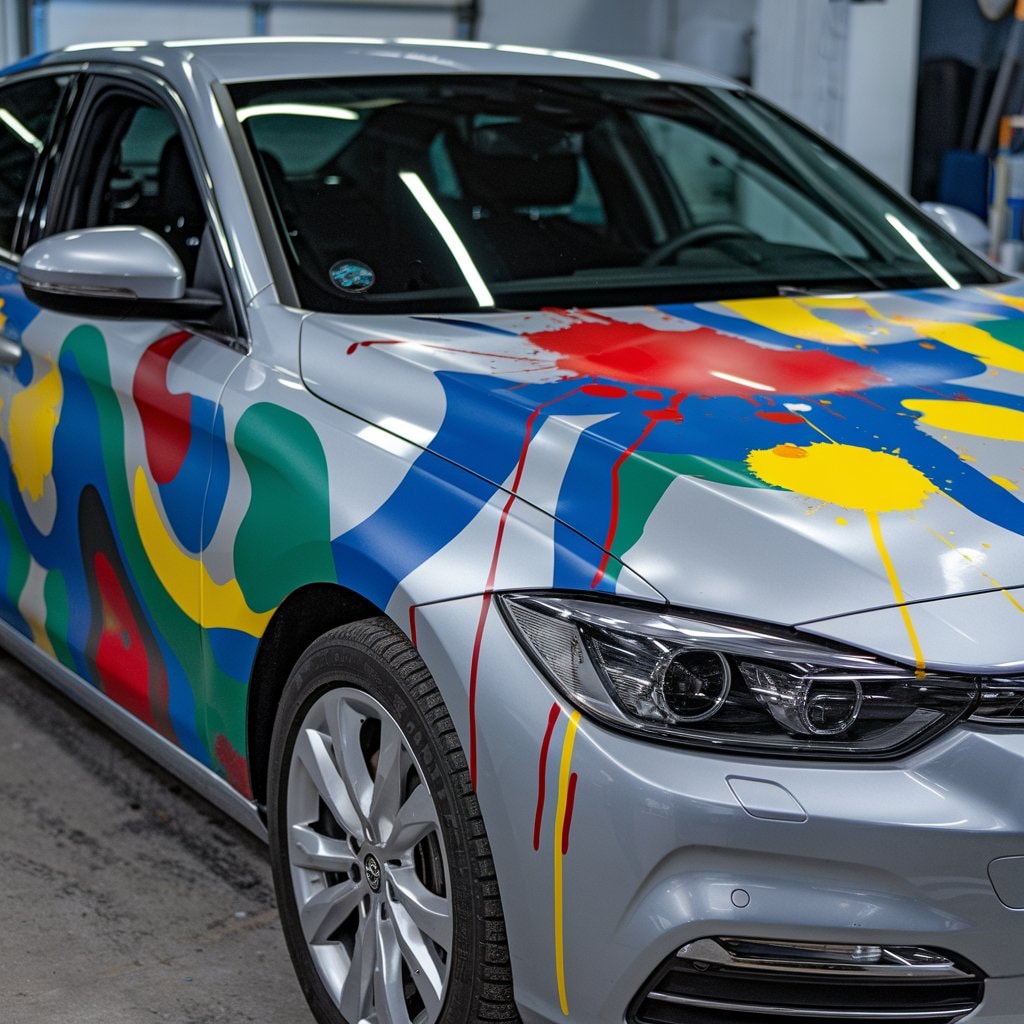
Pros and Cons of Painting Vinyl Wrap on Car Surfaces
When considering modifications to vinyl wrap surfaces on vehicles, the option to paint over the wrap presents both advantages and disadvantages. Understanding these pros and cons is essential for ensuring the desired shape and aesthetic while maintaining the integrity of the Vinyl.
| Pros | Cons | Considerations |
|---|---|---|
| Enhanced Aesthetic | Risk of Peeling | Quality of Paint Matters |
| Customization Options | Potential Damage to Vinyl | Proper Application Required |
| Increased Durability | Difficult to Remove | Compatibility with Vinyl |
| Cost-Effective Alternative | May Void Warranty | Test Small Area First |
Painting over vinyl wrap can effectively fix issues like peeling, allowing for a refreshed appearance. However, it may lead to complications if not executed correctly. The risk of damage to the underlying Vinyl is significant, and improper application can lead to further peeling or bubbling. Additionally, the longevity of the paint job depends heavily on the quality and compatibility with the Vinyl. Ultimately, weighing these pros and cons is vital before deciding to paint over vinyl wrap on car surfaces.
How to Prepare Vinyl on Your Car for Painting
Often, vehicle owners consider painting over vinyl wrap to enhance the appearance or address imperfections. However, proper care and preparation of the Vinyl is vital to guarantee adhesion and prevent future peeling or damage.
The first step in this process is to thoroughly clean the vinyl surface using a mild detergent and water solution. This removes dirt, grease, and any contaminants that could interfere with the vinyl adhesive and paint’s bond.
Next, inspect the Vinyl for any signs of damage, such as peeling or bubbling. If any areas are compromised, it is essential to repair these flaws before proceeding. Use a vinyl repair kit to address any imperfections, assuring a smooth surface for painting.
After repairs, lightly sand the Vinyl with a fine-grit sandpaper. This step creates a texture that helps the paint adhere more effectively. Confirm the surface is completely dry after cleaning and sanding.
Finally, apply a primer designed for Vinyl before painting. This primer will further enhance adhesion and contribute to a uniform finish.
Following these steps will set the stage for a successful painting process, helping to achieve a durable and aesthetically pleasing result on your vinyl-wrapped car.
Best Practices for Painting Vinyl Wrap on Cars
Vinyl wrap offers vehicle owners a versatile aesthetic option, but the decision to paint over it requires careful consideration of best practices. To guarantee a successful application of vehicle wrap, follow these guidelines:
| Best Practices | Details |
|---|---|
| Surface Preparation | Thoroughly clean the vinyl wrapped surface to remove contaminants. Use a mild soap and water solution. |
| Paint Selection | Opt for high quality two pac paint for durability and adhesion. Avoid using solvent-based paints that may damage the vinyl. |
| Application Technique | Apply paint in thin, even coats to prevent drips and peeling vinyl car issues. Use a spray gun or airbrush for prime results. |
Before proceeding, consider the condition of the vinyl wrap. If it exhibits signs of peeling or damage, it may be prudent to repair vinyl car cabinets or other surfaces instead. Properly painted Vinyl can enhance the appearance of your vehicle, but improper techniques can lead to complications. Always test a small area before fully committing to painting over the Vinyl to guarantee compatibility and adhesion.
How to Prevent Vinyl Wrap Peeling on Car Doors
To prevent vinyl wrap from peeling on car doors, regular maintenance is essential.
This includes routine, gentle cleaning products with pH-balanced Solutions and steering clear of abrasive materials that could harm the surface.
Additionally, selecting a high-quality vinyl wrap designed for durability can greatly enhance the longevity and appearance of the wrap.
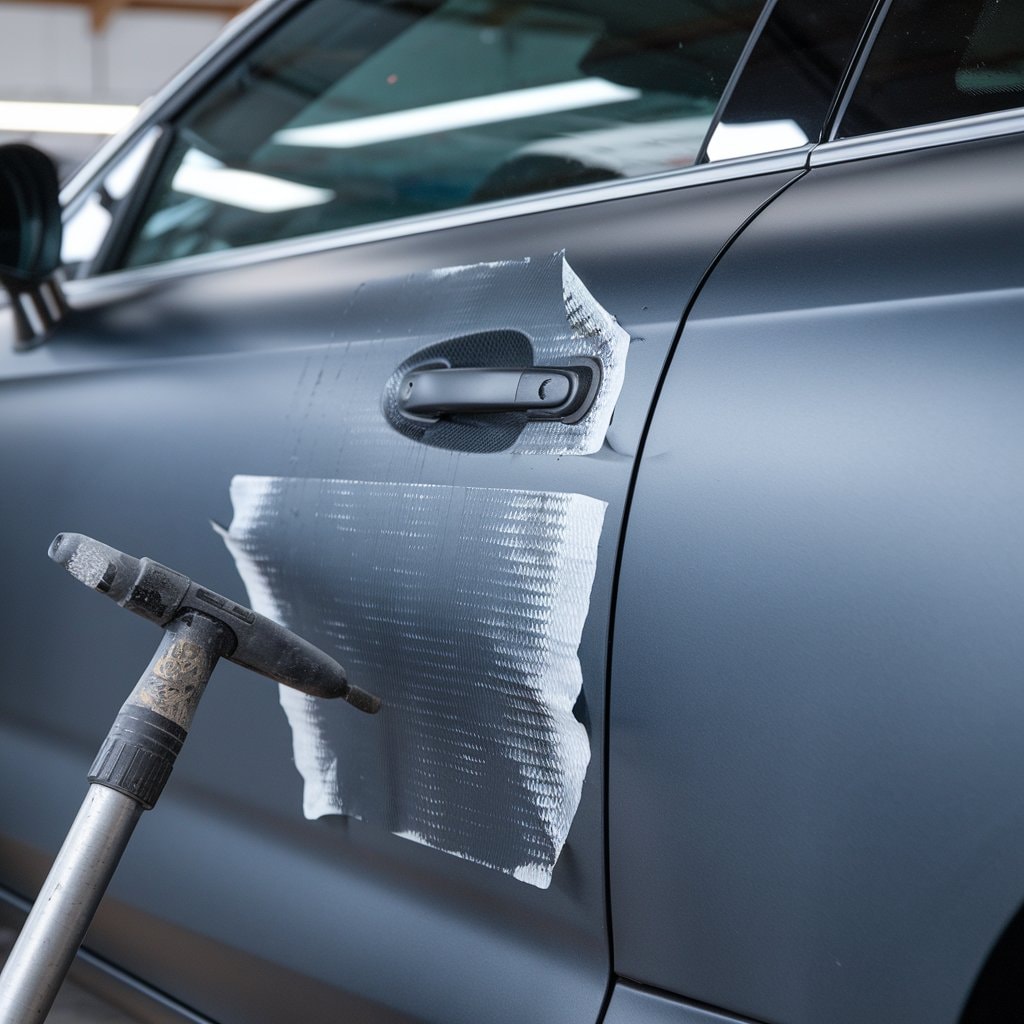
Regular Maintenance Tips for Vinyl Wraps on Cars
Proper upkeep is vital for maintaining the integrity of vinyl wraps on car doors and preventing peeling.
Regular upkeep helps guarantee that the Vinyl is pressed smoothly onto the surface, minimizing the risk of lifting and damage over time.
Here are three key regular maintenance tips:
- Clean Gently: Use a mild soap solution and a soft cloth to clean vinyl surfaces. Avoid abrasive materials that can scratch or lift the Vinyl.
- Inspect Regularly: Periodically check the edges of the Vinyl for signs of lifting or peeling. Early detection allows for timely intervention, preventing further damage.
- Avoid Extreme Conditions: Whenever possible, park your vehicle in shaded areas or garages to shield it from excessive heat and UV exposure, which can degrade the vinyl finish.
Choosing the Right Vinyl Wrap for Longevity on Your Car
When selecting a vinyl wrap for your car, durability and quality are paramount to ascertain longevity and prevent peeling, especially on car doors. The right vinyl wrap can withstand environmental factors and resist the peeling process that often occurs due to poor adhesion or low-quality materials.
Consider the type of Vinyl used; long-lasting Vinyl specifically designed for automotive applications will provide superior performance. Additionally, verify that the application surface, such as medium-density fibreboard for vinyl-wrapped cabinets, is adequately prepared by cleaning and vacuuming to remove any debris that may compromise adhesion.
The following table highlights key characteristics of different vinyl types to help you make an informed decision:
| Vinyl Type | Durability |
|---|---|
| Calendered Vinyl | Shorter lifespan |
| Cast Vinyl | Longer lifespan |
| Glossy Finish Vinyl | Scratch-resistant |
| Matte Finish Vinyl | Trendy but less durable |
Choosing high-quality Vinyl wraps not only enhances the aesthetic appeal of your car but also minimizes the risk of peeling, verifying that your investment lasts for years to come.
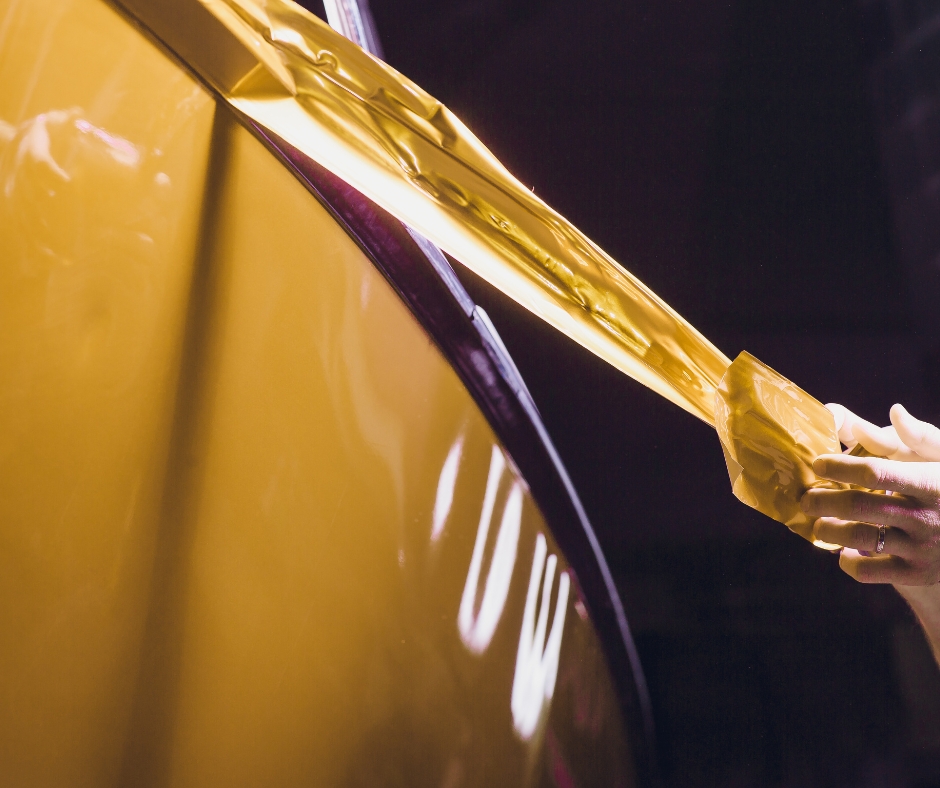
When to Contact a Professional for Vinyl Wrap Repair?
Identifying when to seek professional assistance for vinyl wrap repair is vital for maintaining your vehicle’s appearance and integrity.
Signs such as significant peeling, bubbling, or discolouration often indicate that expert intervention is necessary.
Engaging a professional not only guarantees a high-quality repair but also provides insight into cost considerations that can impact your decision.
Signs You Need Professional Help with Your Car’s Vinyl Wrap
A vinyl wrap can elevate the look of your car, but signs of damage or deterioration can indicate the need for professional intervention. Overlooking these issues could result in additional complications, including more extensive damage and increased repair costs.
Here are three key signs you need professional help with your car’s vinyl wrap:
- Starting to Peel: If you notice sections of the Vinyl starting to peel away from your vehicle, it is imperative to address this issue promptly. Delaying repairs can result in larger areas of the wrap lifting.
- Bubbles and Wrinkles: The formation of bubbles or visible wrinkles can compromise the aesthetic appeal of your car. If these imperfections do not improve with basic maintenance, seeking professional assistance is advisable.
- Colour Fading: Extended exposure to sunlight can lead to the Vinyl fading. If the colour of your wrap is markedly duller or uneven, it may be time to consult an expert for a solution.
Recognizing these signs is essential in the process so your doors maintain their pristine appearance.
Don’t wait for the Vinyl to come off until it starts causing irreversible damage; act swiftly.
Benefits of Hiring a Professional Vinyl Wrap Specialist for Cars
Many car owners find themselves at a crossroads when it comes to maintaining their vehicle’s vinyl wrap. When faced with issues like peeling or lifting, the decision to seek professional assistance can greatly impact the outcome.
A professional vinyl wrap specialist possesses the expertise and tools necessary for effective repair. They can evaluate the severity of the damage, making sure that the Vinyl adheres properly and that the repair integrates smoothly with the existing wrap.
Moreover, experts are knowledgeable about the specific requirements of different vinyl materials, which is essential for achieving a durable and aesthetically pleasing result. Attempting a DIY repair may lead to further complications, such as mismatched colours or misaligned edges, ultimately compromising the vehicle’s appearance and value.
Moreover, hiring a specialist can save time and mitigate the risk of damaging the wrap further, allowing for a quicker turnaround. Just as one would seek a professional for a vinyl-wrapped car renovation, the same principle applies to automotive vinyl repairs.
Cost Considerations for Professional Vinyl Repair on Car Doors
Evaluating the cost considerations for professional vinyl repair on car doors is essential for car owners facing issues like peeling or bubbling. Understanding these costs can assist you in making informed choices about repairing or replacing your vinyl wrap.
When considering professional repair, take these factors into account:
- The extent of Damage: Minor issues may only require localized repairs, while extensive peeling might necessitate a complete rewrap, considerably increasing the cost.
- Type of Vinyl: The price can vary based on the quality of the Vinyl used. Higher-grade Vinyl, often used in applications like vinyl-wrapped car cabinets, could incur higher costs but offer better durability.
- Labour Costs: Labor rates can vary by region. While the cost of replacing vinyl wraps can be high, opting for a repair may be a more economical choice, serving as a cheaper alternative to timber options.
For tailored advice, feel free to contact us. We can help evaluate your specific situation and provide insights on the option to repair vinyl car surfaces or car doors effectively.
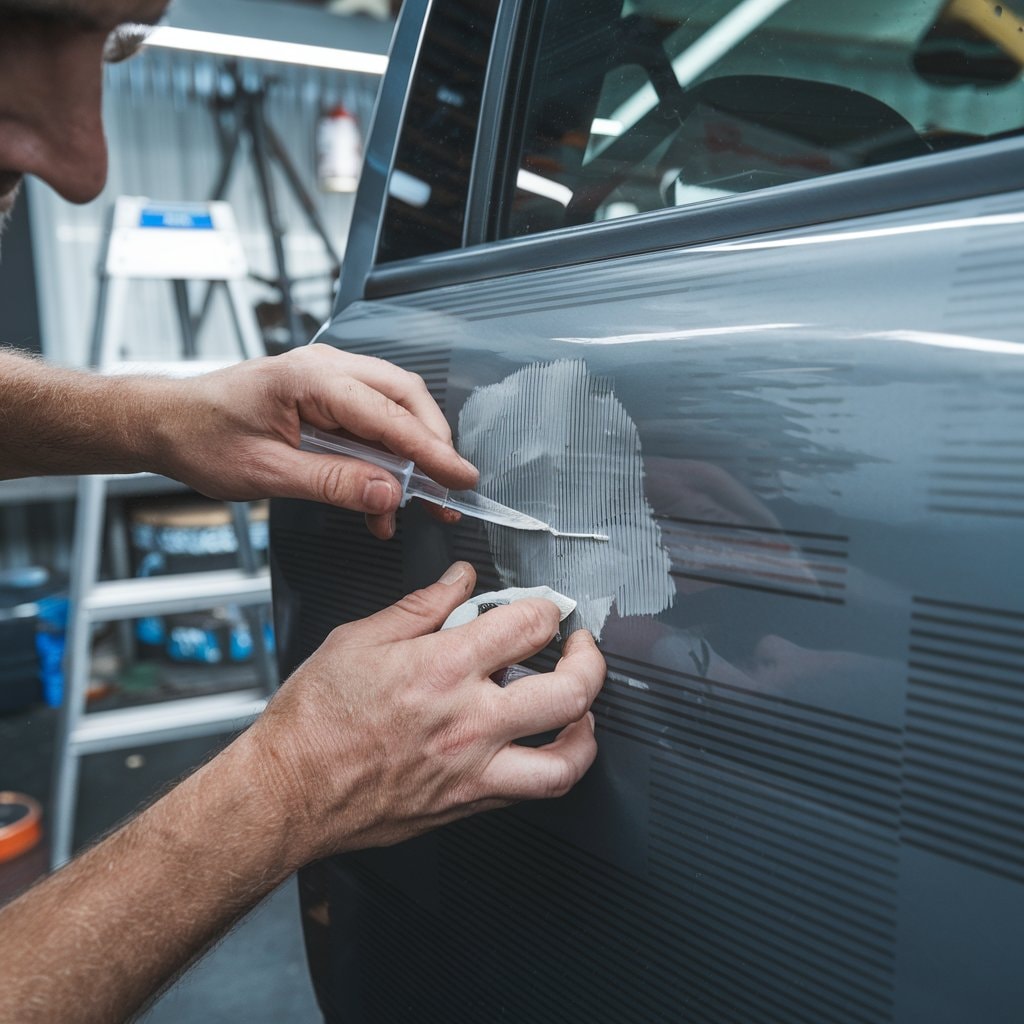
Conclusion
In summary, addressing lifted or peeling vinyl wrap on car doors necessitates understanding the underlying causes, which may include poor application or environmental factors. Preventive actions can significantly prolong the lifespan of vinyl wraps while painting over Vinyl is generally not advisable. When repairs exceed personal expertise, seeking professional assistance is recommended to guarantee ideal results. Regular maintenance and vigilant monitoring of the wrap’s condition will help maintain the aesthetic and protective qualities of the Vinyl.


